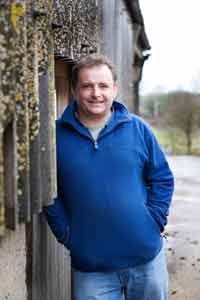Case study – Controlling IBR in the beef herd

Testing for disease is as much about identifying the absence of disease as the presence, according to Surrey beef farmer Angus Stovold. “When you know your disease status, you can manage the risk of infection.”
Having an accredited disease free herd is high priority for Mr Stovold (pictured) who farms his 145-cow suckler herd of pedigree Aberdeen Angus at Lydling Farm, Shackleford.
“We sell a lot of bulls and show a number of females every year, so having a high health-status herd is essential.”
And after their vet made them aware of the potential risk of IBR infection, particularly to naïve animals, Mr Stovold introduced a number of disease control strategies.
“Although we have always been biosecurity-aware and quarantined bought-in bulls for three weeks, we never used to blood-test,” he says.
“Now we only buy bulls from accredited herds and blood test them for all key diseases.”
Infection is still possible even in a closed herd, says Mr Stovold’s vet Hugh Thomson, Westpoint Vet Group. “The fertility and disease implications of IBR are potentially catastrophic – and because IBR is spread via respiratory and ocular secretions, livestock shows offer even more of a risk of disease spread.
“With such a large number of animals sharing the same air space, one IBR carrier animal has the potential to infect a large number of animals in a relatively short period of time.”
As a consequence, Mr Stovold has upped biosecurity to minimise the risk of infection. “There is always risk of exposure from herds that do not know their disease status,” he says. “As a result we ensure we arrive at shows early and position ourselves next to people of similar health status, close to the door for good ventilation.
“We also don’t share buckets or take water from shared troughs as this can act as another source of disease transmission.”
The 15 show animals are also housed separately from the main herd from February until October. “Show stock are blood-tested three weeks after the last show and re introduced into the herd two weeks later when results come back clear – this is essential to remain CHeCS-accredited.”
The herd at Lydling Farm has been accredited free of BVD, leptospirosis, IBR and Johne’s for ten years. To become IBR accredited, all animals over the age of 12 months should test negative for disease after two tests one to 12 months apart, Mr Thomson explains.
To maintain this status, bloods should be taken from a statistical sample of animals, as well as any bulls and non homebred stock, on a yearly basis.
To ensure visitors do not pose an added risk of infection, all vehicles stop in a “dirty area” outside where the livestock is housed, says Mr Stovold. “No strange vehicles are allowed past this point and all visitors must disinfect their boots upon arrival.”
Our main aim is to protect the health status of the herd, but remain unvaccinated for IBR, says Mr Stovold. “People are demanding disease-free bulls but, if we vaccinated, we would be unable to use them for export AI.”
And because the herd is largely closed, with all replacements reared on farm and some bulls bought in, non vaccination was possible.
“It is farm-specific as to whether you decide to vaccinate. When a farm is buying in replacements then vaccinating for IBR may be necessary.”
However, from a safety point of view, vaccination is advisable, says Mr Thomson. “It is possible to vaccinate with a marker vaccine so vaccinated animals can be distinguished from disease positive individuals.” And crucially, you can vaccinate with marker vaccine and still be accredited disease-free.
However, stricter controls do exist with semen exports. “Controls vary depending on different countries, but because IBR can be spread via semen, some countries demand semen is completely clear of antibodies – ruling out the use of vaccines.
“However, in most cases, the cost benefit of protecting against IBR through vaccination far outweighs the gain from future semen export,” stresses Mr Thomson.
